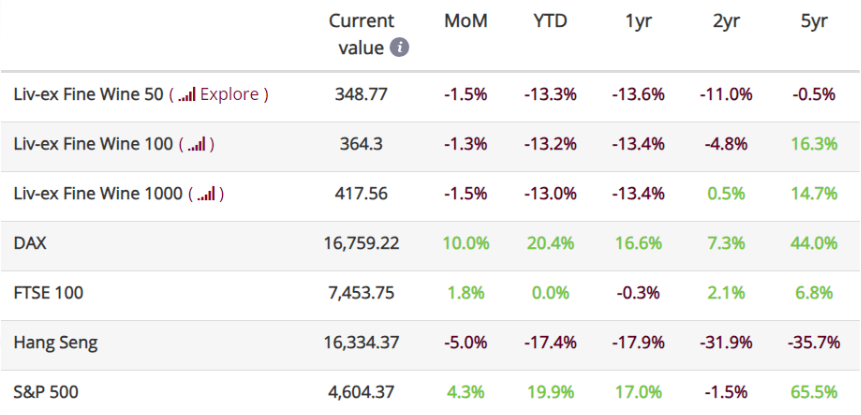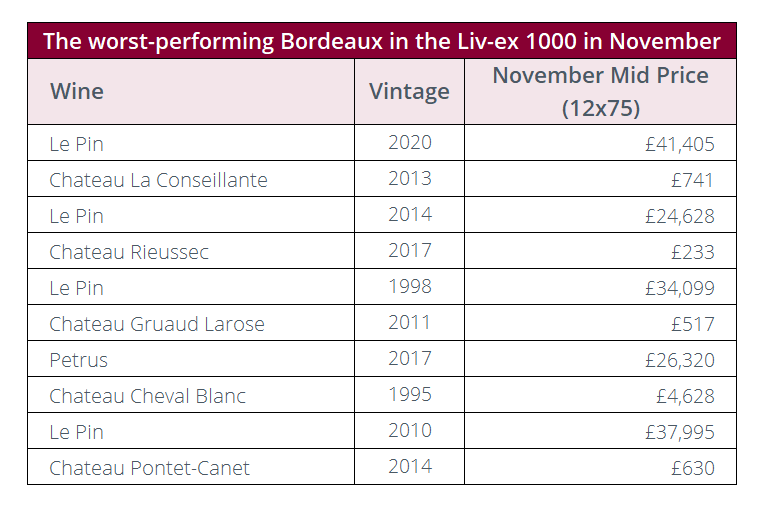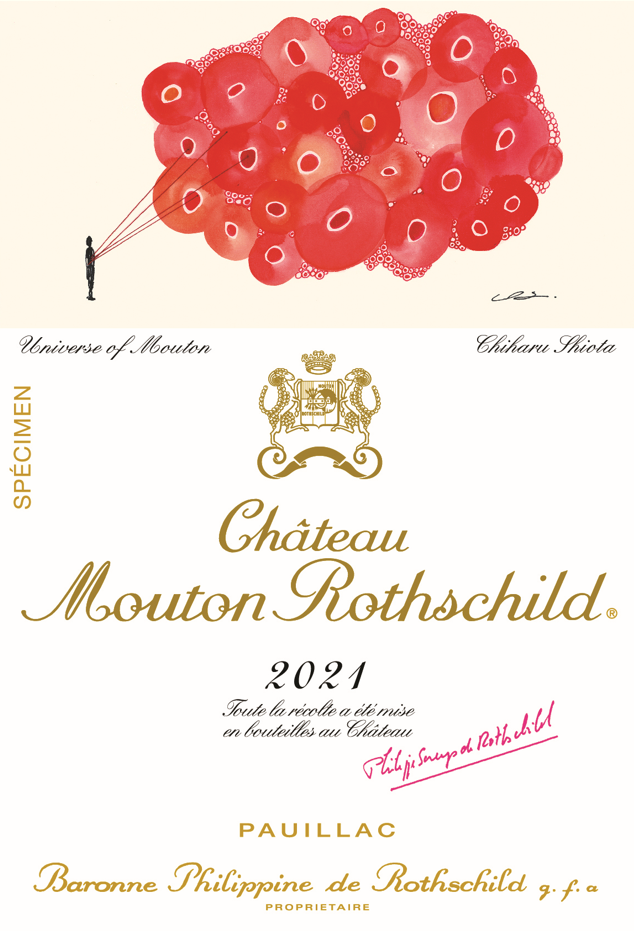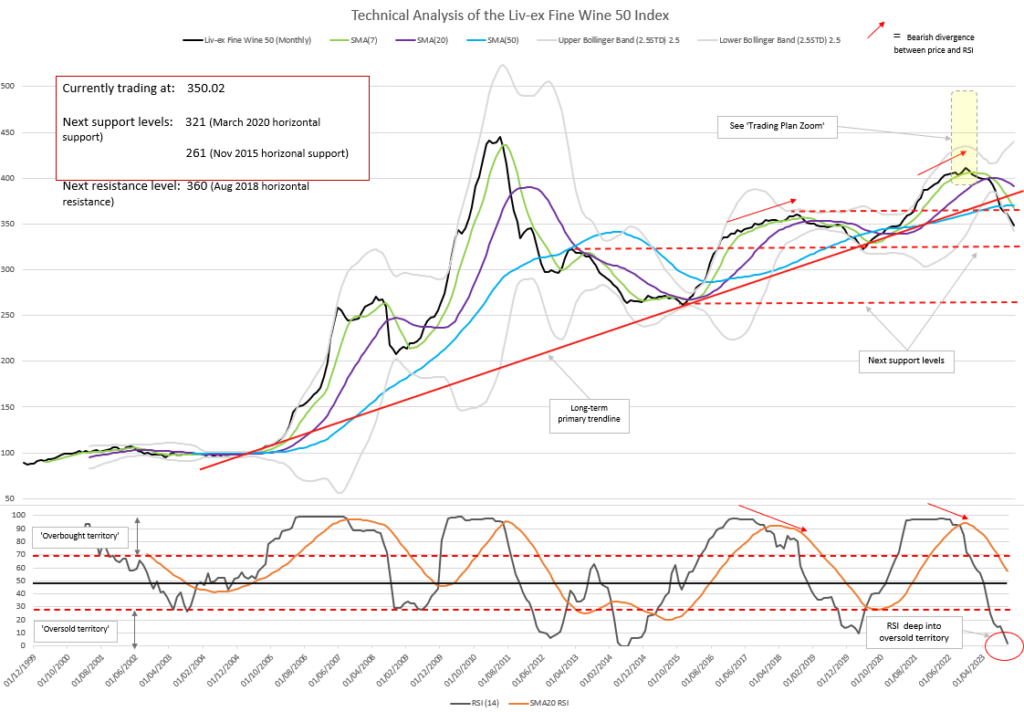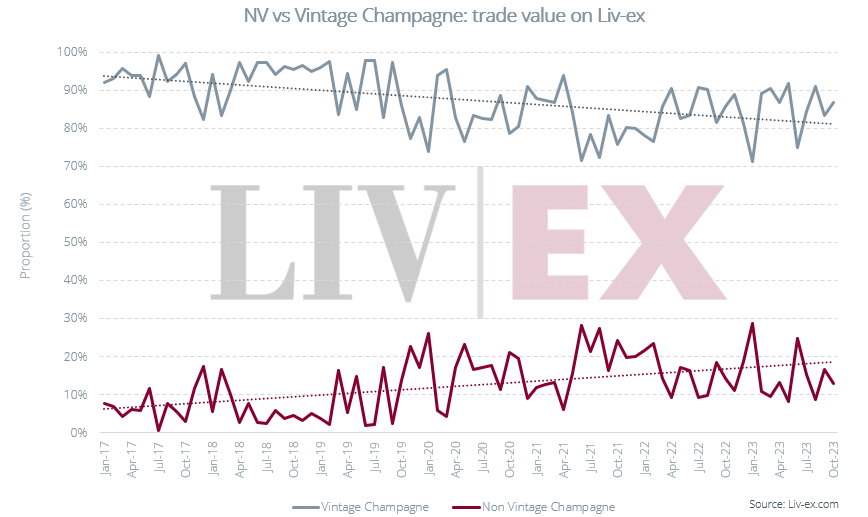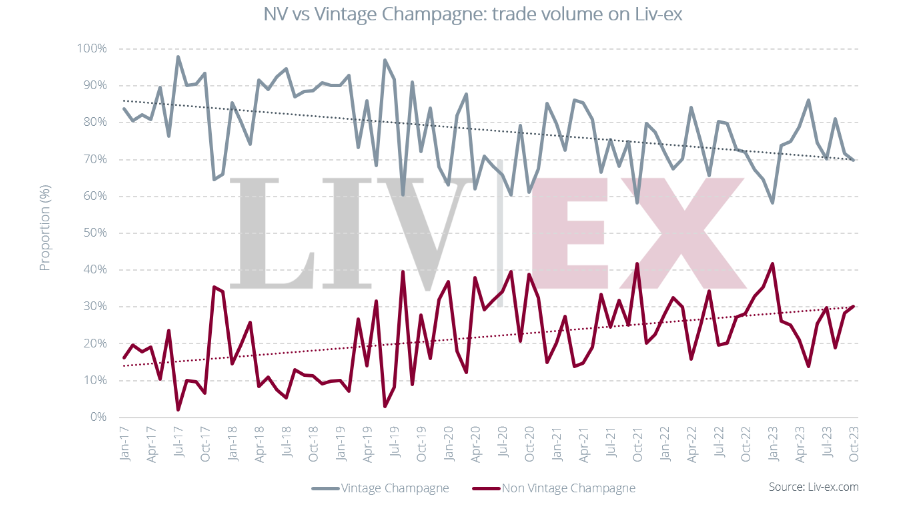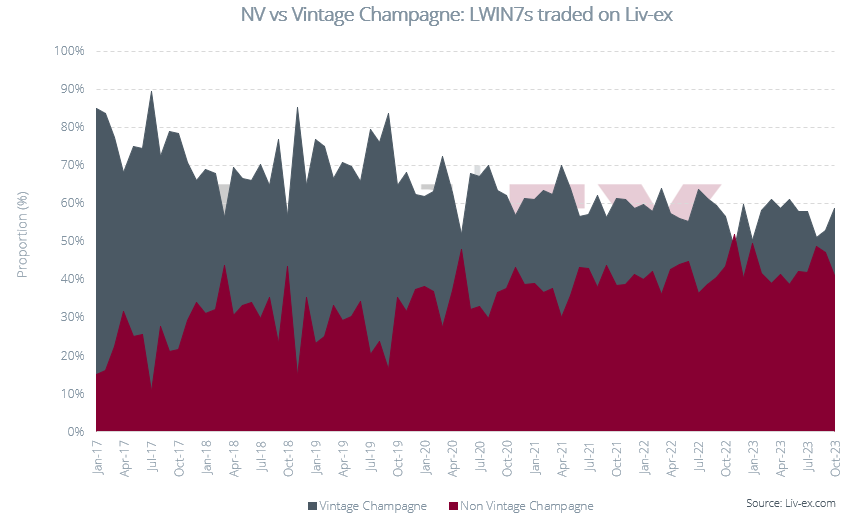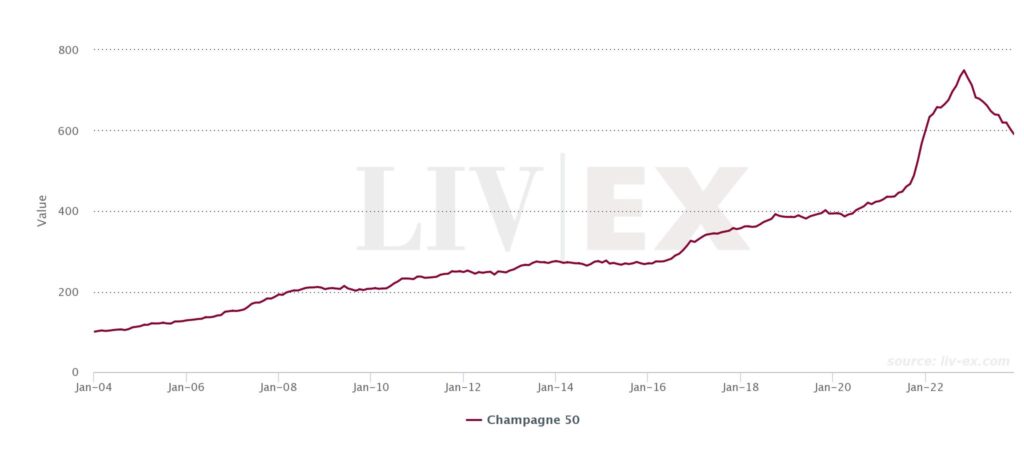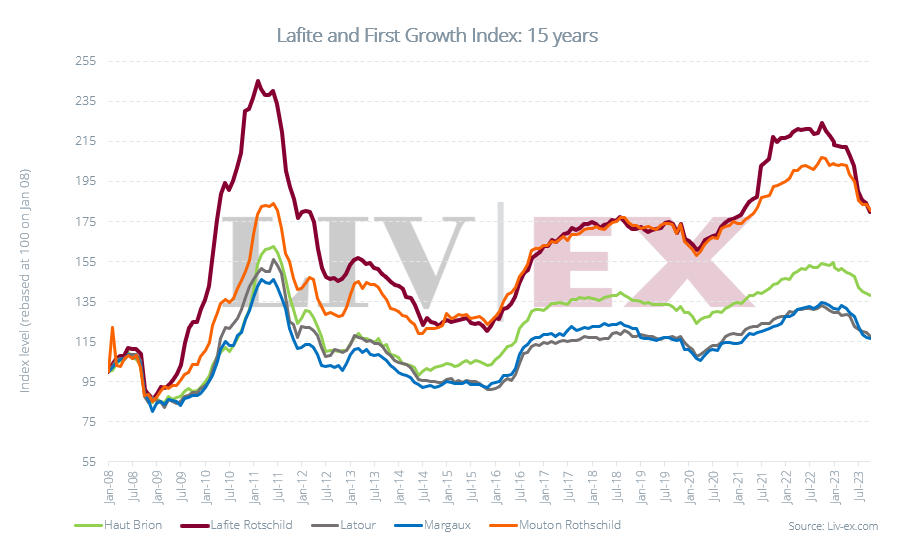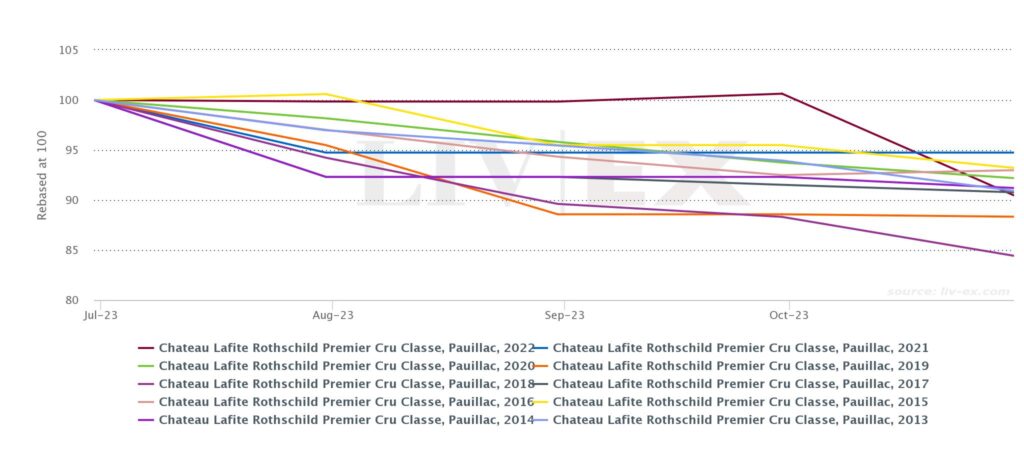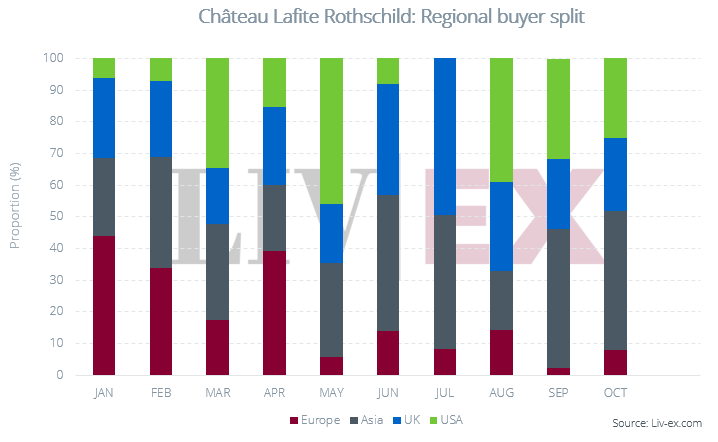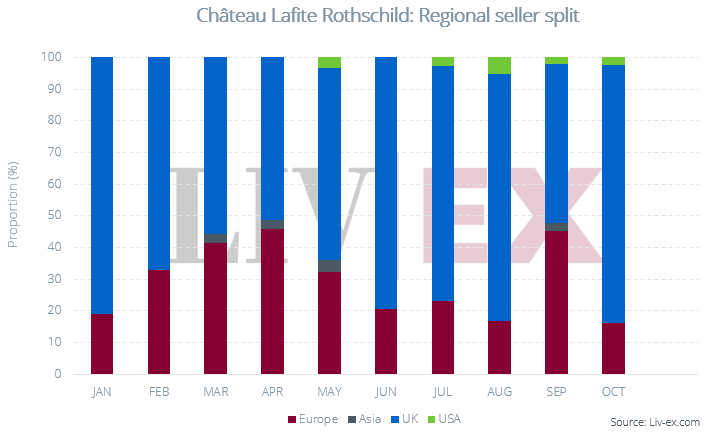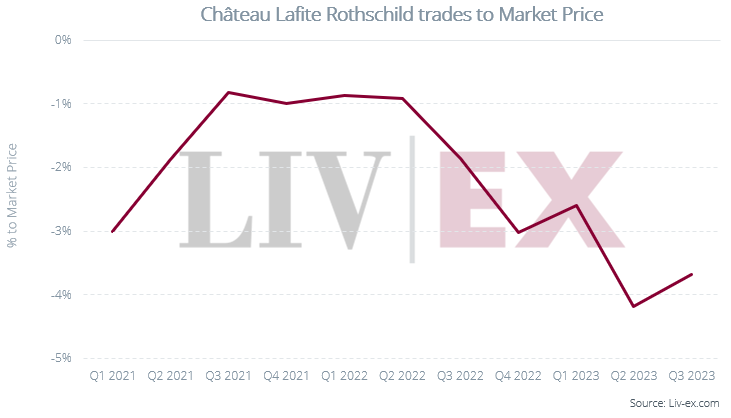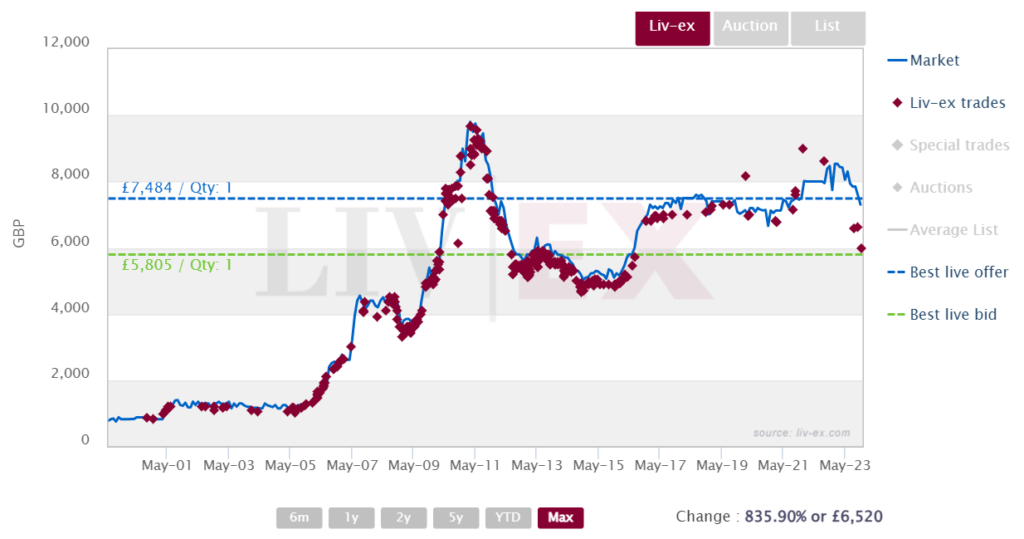December Market Report
Share this article | Print this article
- All major Liv-ex indices fell once again.
- The best performer among the sub-indices of the Liv-ex 1000 was the Italy 100, which fell by 0.7% month-on-month.
- Mouton Rothschild 2021, newly-adorned with its label, went under the gavel at Christie’s earlier this month.
- Technical Analysis can be used to design trading plans; this month, we build one to trade the Liv-ex Fine Wine 50.
- Non-vintage Champagne has been making waves on the secondary market, gaining market share against its vintage counterpart.
- Château Lafite Rothschild has been the worst performer in the Fine Wine 50 in 2023. What is behind this decline?
Introduction
Safety in numbers
*data taken on the 11th of December 2023. The FTSE 100 was last updated on the 31st of November. The Liv-ex Fine Wine 50 is updated daily.
In the penultimate update of 2023, all major Liv-ex indices fell once again. The Liv-ex Fine Wine 100, the industry benchmark, dropped 1.3% month-on-month to close at 364.3, an improvement on last month’s 1.9% drop. The Liv-ex Fine Wine 50, which tracks the daily price movements of First Growths, fell by 1.5% in November (note: the index is updated daily).
Looking at the broader market, the Liv-ex Fine Wine 1000 also fell by 1.5% in November compared to 1.4% the month before. Other markets were a lot healthier: the DAX was up 10% month-on-month on the 11th of December, the S&P 500 4.3%, the FTSE 100 up 1.8%. Only the Hang Seng dipped 5.0%, negatively affected by continued economic headwinds in China and Moody’s recent downgrade of the country’s sovereign debt.
Despite the continued downturn, trading activity on the exchange saw an uptick in November, both in terms of value and volume. Market breadth, however, retracted slightly as 2,185 individual labels (LWIN11s) traded on Liv-ex over the month.
Our annual report, The Fine Wine Market in 2023, looks back on the challenging year that is coming to an end. The outlook for 2024 is not as rosy as we would like, but what is sure is that there is strength in numbers – or in this case, in the data. This monthly report outlines new, innovative ways in which Liv-ex is making data available to its members, whether it’s the outcome of historic auction events or technical analysis tools. More analysis, data and insights to come in the new year.
Major Market Movers
The tug of war
In November, all sub-indices of the Liv-ex 1000 fell. The declines ranged from just 0.7% for the Italy 100 to 2.2% for the Champagne 50.
Inside the Liv-ex 1000, the broadest measure of the market, 300 wines saw their Mid-Prices rise month-on-month, 180 remained flat, and 520 fell. There is little sense to be made from the rising and falling components of the index.
Among the worst performers in the index are three vintages of Le Pin, the 2000 falling by 21.6% month-on-month, the 2014 by 17.8% and the 1998 by 13.6%. Ten Bordeaux wines recorded double-digit declines in the last month:
Five wines from Domaine de la Romanée-Conti also saw their Mid-Prices decline by more than 10% month-on-month: Grands Echezeaux Grand Cru 2012 (-17.8%) and 2018 (-11.7%), Romanée-Conti Grand Cru 2012 (-14.4%), La Tâche Grand Cru 2013 (-13.9%) and 2019 (-13.5%).
At the top of the index’s best performers feature a handful of Rhône labels such as Paul Jaboulet Aîné, Hermitage, La Chapelle Rouge 2013 (+14.9%).
News Insight
Château Mouton Rothschild 2021 gets a new suit and goes under the gavel
On the 1st of December, Château Mouton Rothschild revealed the bottle adorning the bottles of its 2021 vintage, created by Japanese artist Chiharu Shiota. The label shows a silhouette in the face of ‘gorgeous, generous nature’, according to the press release, ‘holding onto the balance between nature and humans’.
As is customary following the announcement of the new label, an auction has been held at Christie’s selling an assortment of formats of Château Mouton Rothschild 2021: six bottles, three magnums, a double magnum signed by the artist and the Rothschild family, an imperial and the only Nebuchadnezzar of the wine available.
Historical auction data for any wine can now be viewed on their individual wine pages by Liv-ex members on Silver packages and above. Users can filter by format (cases, bottles, magnums, and more), Auction Location, and see up to the last 20 auction events we have recorded. Our database holds over 900,000 events from major houses including Sotheby’s, Christie’s, Acker and Zachy’s and covers 190,000 wines.
Château Mouton Rothschild 2018 historical auction data on Liv-ex
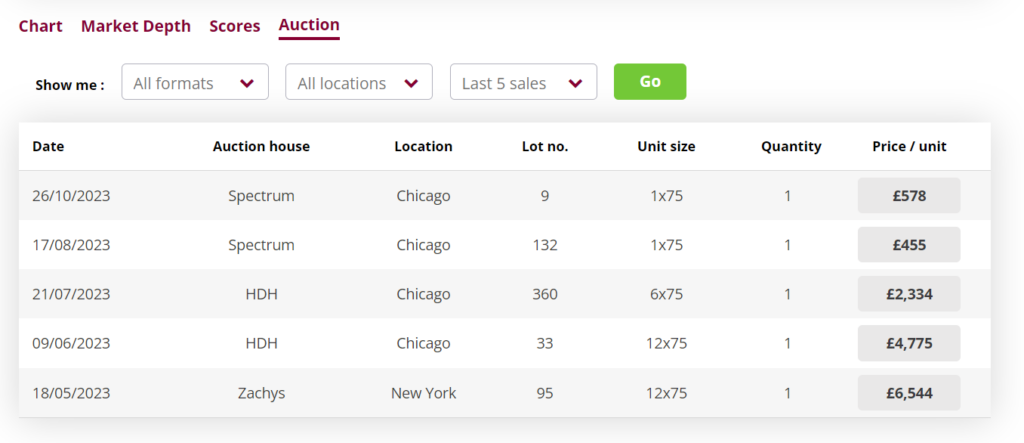
This historical auction data adds to a growing hub of data points where members can check prices, including to set or benchmark their auction bids, for example. Members on Gold packages and above can also see ABV data on individual wine pages, while Mid-Prices, which are used to calculate Liv-ex indices, are available upon request.
To get access to these data points, speak to your Account Manager:
Chart of the Month
Trading the Fine Wine 50
In the following section, we will show how technical analysis can help us design a trading plan, and how the analysis of price data over multiple timeframes can help to identify an optimal entry point to trade the index.
For the purposes of this analysis, we will be looking at the Liv-ex Fine Wine 50, which tracks the movements of First Growths, on a monthly, weekly and daily basis. This a preview of a full trading plan, which can be accessed below.
Above we can see that the price of the Liv-ex 50 has been falling since its top in September 2022. The recent price action broke not only through the Simple Moving Averages (SMA) 7 months and 20 months, but more importantly the SMA50 and the long-term primary trendline initiated in 2005.
This is a major threat to the index’s long-term bullish trend. We have not yet seen a re-test of the long-term ascending trendline; on the contrary, the price has now dropped below the 2018 highs.
Since its 2021/2022 highs, the Liv-ex 50’s price has so far seen a 15% correction. Was there any way we could have anticipated this drop and sell the Index or hedge long positions?
Read the full trading plan for the Liv-ex Fine Wine 50.
Critical Corner
The age of non-vintage Champagne
James Suckling recently announced Laurent Perrier Grand Siècle N.26 as his top wine of the year out of the almost 39,000 wines he rated, noting that what makes the wine ‘so magical is its exceptional blend of vintages, three beautiful years with the uniquely powerful 2008 vintage giving it the edge’. He also mentions that Champagne has ‘increased the production of table wines in the area, with pinot noirs and chardonnays now comparing to the best of Burgundy’.
Jeb Dunnuck also released a Champagne 2023: Current and Upcoming Releases regional report in which six NV champagnes secured spots among the top 25, including Jacques Selosse Substance Blanc de Blancs NV and Ulysse Collin Blanc de Blancs Les Pierrières Extra Brut NV which received scores of 98 and 98+ points, respectively.
Looking at the Liv-ex exchange figures, while trade value has remained relatively steady for both non-vintage and vintage Champagne, the former has seen its trade value gradually increase over time. In terms of trade volume, the story is much the same: non-vintage Champagne is increasing as a proportion of all Champagne traded on the exchange.
This aligns with the increasing number of NV Champagne LWIN7s on the exchange, outpacing the exposure and trading rates of vintage Champagne LWIN7s. At the beginning of 2017, 64.2% of Champagne LWIN7s exposed were vintage, compared to 35.8% non-vintage ones. In October 2023, these figures have shifted to 51.8% for vintage and 48.3% for non-vintage.
This trend extends to actual trades on the exchange: the gap between vintage and NV Champagne is narrowing. Currently, vintage Champagne accounts for 58.8% of all Champagne trades while NV Champagne makes up 41.2%, a significant shift from the 85% – 15% NV split back in January 2017.
The surge in NV Champagne’s popularity could be attributed to a few factors. One is the increasing number of these wines available on the market and their improving quality. Another is the sheer amount of volume available compared to vintage Champagnes. As a category, Champagne is particularly liquid and buoyed by demand from drinkers even during market downturns; non-vintages Champagnes are just an extreme example of that.
Of course, the rise of non-vintage Champagnes on the secondary market is also a product of the times. The shift in LWIN7 exposure and trading patterns on Liv-ex reflects changing market conditions, as drinkers seek more affordable alternatives to vintage Champagnes whose prices skyrocketed in summer 2022.
Now, in a downward market, non-vintage Champagne is positioning itself as a quality but relatively better-priced option, no longer limited to beginners but gaining recognition among all buyers. The high scores some command attest to their improving quality, suggesting that as buyers are giving them more attention, so are producers who are investing in these labels.
Final Thought – Château Lafite Rothschild: What goes up, must come down
Château Lafite Rothschild is one of the five wines of the Liv-ex Fine Wine 50 index, which tracks the daily price movements of the Bordeaux First Growths. The index has declined by 13.7% over the last year and 10.1% over the last two.
Lafite has been an important contributor to this decline, being the worst performer within the index. The wine’s vintages within the Fine Wine 50 have, on average, experienced a 17.8% drop in their one-year performance and a 15.7% decrease in their two-year performance.
What’s behind Lafite’s fall from heaven?
During the Asia-led fine wine boom of 2009 to 2011, Château Lafite Rothschild emerged as a ‘super brand’ in China, reaching unprecedented heights in terms of both prestige and price.
However, the subsequent market correction in 2011 marked the beginning of a challenging period for Lafite; prices experienced a significant decline (the index saw a 39.2% drop from its peak in June 2011 to August 2012), and the dynamics around the brand began to shift.
Fast forward to the present day and Lafite is, like the fine wine market as a whole, undergoing another price correction.
The strength of the demand and ensuing price increases of Lafite can be seen by looking at fellow First Growth Château Mouton Rothschild. As per the chart above, the two brands’ indices have followed remarkably similar trajectories from July 2014 until July 2021, when Lafite rose to much higher highs than Mouton.
Since its peak last summer, Château Lafite has retraced 19.8% to Château Mouton’s 12.7%.
Recent vintages take a hit
Year-to-date, all ten of the most recent physical vintages of Lafite have displayed negative performances. The 2018 and 2019 vintages experienced the most significant declines since July 2023, closely followed by 2020. This is a common pattern observed during a downturn, when merchants look to shift recent vintages with comparatively higher stock volumes.
Changes in Lafite’s prices are closely tied to the Asian market.
Once a powerhouse of demand, Asia is facing challenges such as increased regulation, anti-corruption drives and an oversaturation of wine in the region. Consequently, said demand has waned and UK merchants, who were accustomed to catering to the Asian market, have found themselves with excess stock.
Who has bought and sold Lafite this year?
In 2023, UK merchants accounted for an average of 26.8% of all monthly Lafite purchases on Liv-ex, while the Asian market, despite challenges, held a more significant share at 33.2%. However, when it came to selling, UK merchants dominated, with a monthly average of 68.0% of all Lafite sales conducted.
How has Lafite been trading in relation to its Market Price?
The oversupply in Asia has led to an increased discount in trade prices against the Market Price, as seen in the graph above.
One such example is Château Lafite 1998 which last traded at £6,000, 17.8% below its Market Price of £7,300 per case. Although this trade still a huge premium to the wine’s initial release price, it falls significantly short of its peak trade value in 2011, which stood at £9,650 per 12×75 and points to further declines in the market price for the wine.
Château Lafite Rothschild 1998 trades on Liv-ex

